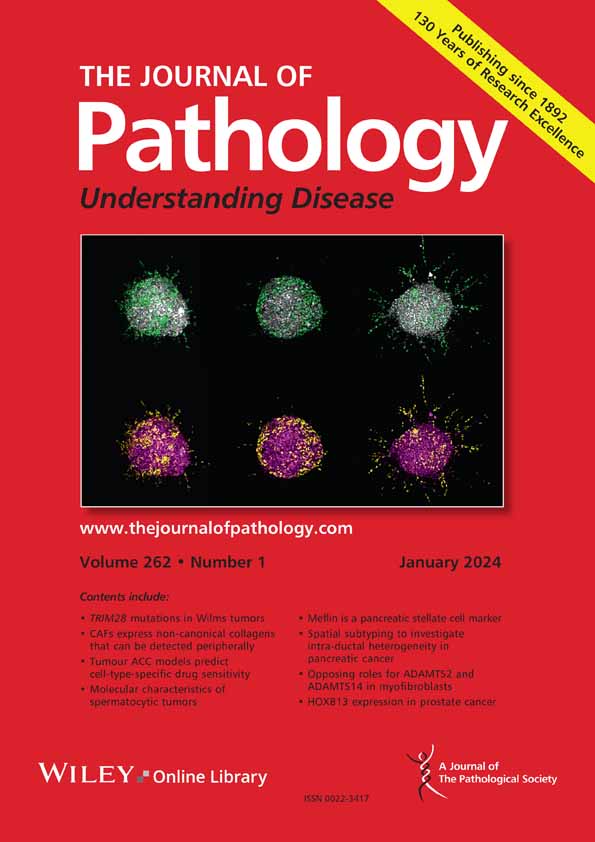Masafumi Horie, Hiroshi Takumida, Hayato Koba, Tsukasa Ueda, Hidenori Tanaka, Masami Suzuki, Yukinobu Ito, Ayumi Ito, Mao Kondo, Hiroshi I Suzuki, Isao Matsumoto, Seiji Yano, Akira Saito, Daichi Maeda
下载PDF
{"title":"Characteristic miRNA profiles represent clinicopathological diversity of small cell lung cancer","authors":"Masafumi Horie, Hiroshi Takumida, Hayato Koba, Tsukasa Ueda, Hidenori Tanaka, Masami Suzuki, Yukinobu Ito, Ayumi Ito, Mao Kondo, Hiroshi I Suzuki, Isao Matsumoto, Seiji Yano, Akira Saito, Daichi Maeda","doi":"10.1002/path.6458","DOIUrl":null,"url":null,"abstract":"<p>Small cell lung cancer (SCLC) is classified into distinct molecular subtypes based on the expression patterns of four transcription regulators: achaete–scute homolog 1 (ASCL1), neuronal differentiation 1 (NEUROD1), POU class 2 homeobox 3 (POU2F3), and yes-associated protein 1 (YAP1). MicroRNAs (miRNAs) play critical roles in cancer cellular processes but their subtype-specific implications in SCLC remain underexplored. Out of 46 surgically resected SCLC samples, miRNA visualization through <i>in situ</i> hybridization identified high expression of miR-375 in the ASCL1, NEUROD1, and ASCL1/NEUROD1 subtypes, and miR-9-5p in the POU2F3 subtype. Comprehensive enhancer profiling using SCLC cell lines indicated that miR-375 and miR-9-5p were regulated by super-enhancers in a subtype-specific manner. Multiplex immunohistochemistry by imaging mass cytometry found that the miR-9-5p-high SCLC was characterized by a higher stromal area ratio, increased numbers of CD8<sup>+</sup> T cells and CD163<sup>−</sup> macrophages in the intra-tumoral area, and an increased number of plasma cells in the stromal area, as compared with the miR-9-5p-low SCLC. Finally, clinicopathological analysis revealed that the miR-375-high SCLC was associated with YAP1 downregulation, increased serum pro-gastrin-releasing peptide levels, and poor prognosis. These findings highlight the critical role of super-enhancer-related miRNAs in the diversity of SCLC, and underscore the potential for novel diagnostic and prognostic biomarkers based on these subtype-specific miRNAs. © 2025 The Author(s). <i>The Journal of Pathology</i> published by John Wiley & Sons Ltd on behalf of The Pathological Society of Great Britain and Ireland.</p>","PeriodicalId":232,"journal":{"name":"The Journal of Pathology","volume":"267 2","pages":"168-180"},"PeriodicalIF":5.2000,"publicationDate":"2025-08-22","publicationTypes":"Journal Article","fieldsOfStudy":null,"isOpenAccess":false,"openAccessPdf":"https://www.ncbi.nlm.nih.gov/pmc/articles/PMC12438024/pdf/","citationCount":"0","resultStr":null,"platform":"Semanticscholar","paperid":null,"PeriodicalName":"The Journal of Pathology","FirstCategoryId":"3","ListUrlMain":"https://pathsocjournals.onlinelibrary.wiley.com/doi/10.1002/path.6458","RegionNum":2,"RegionCategory":"医学","ArticlePicture":[],"TitleCN":null,"AbstractTextCN":null,"PMCID":null,"EPubDate":"","PubModel":"","JCR":"Q1","JCRName":"ONCOLOGY","Score":null,"Total":0}
引用次数: 0
引用
批量引用
Abstract
Small cell lung cancer (SCLC) is classified into distinct molecular subtypes based on the expression patterns of four transcription regulators: achaete–scute homolog 1 (ASCL1), neuronal differentiation 1 (NEUROD1), POU class 2 homeobox 3 (POU2F3), and yes-associated protein 1 (YAP1). MicroRNAs (miRNAs) play critical roles in cancer cellular processes but their subtype-specific implications in SCLC remain underexplored. Out of 46 surgically resected SCLC samples, miRNA visualization through in situ hybridization identified high expression of miR-375 in the ASCL1, NEUROD1, and ASCL1/NEUROD1 subtypes, and miR-9-5p in the POU2F3 subtype. Comprehensive enhancer profiling using SCLC cell lines indicated that miR-375 and miR-9-5p were regulated by super-enhancers in a subtype-specific manner. Multiplex immunohistochemistry by imaging mass cytometry found that the miR-9-5p-high SCLC was characterized by a higher stromal area ratio, increased numbers of CD8+ T cells and CD163− macrophages in the intra-tumoral area, and an increased number of plasma cells in the stromal area, as compared with the miR-9-5p-low SCLC. Finally, clinicopathological analysis revealed that the miR-375-high SCLC was associated with YAP1 downregulation, increased serum pro-gastrin-releasing peptide levels, and poor prognosis. These findings highlight the critical role of super-enhancer-related miRNAs in the diversity of SCLC, and underscore the potential for novel diagnostic and prognostic biomarkers based on these subtype-specific miRNAs. © 2025 The Author(s). The Journal of Pathology published by John Wiley & Sons Ltd on behalf of The Pathological Society of Great Britain and Ireland.
特征miRNA谱代表了小细胞肺癌的临床病理多样性。
基于四种转录调控因子的表达模式,小细胞肺癌(SCLC)被划分为不同的分子亚型:无鳞片同源物1 (ASCL1)、神经元分化1 (NEUROD1)、POU2类同源盒3 (POU2F3)和ye相关蛋白1 (YAP1)。MicroRNAs (miRNAs)在癌细胞过程中发挥着关键作用,但其在SCLC中的亚型特异性意义仍未得到充分研究。在46例手术切除的SCLC样本中,通过原位杂交miRNA可视化发现,miR-375在ASCL1、NEUROD1和ASCL1/NEUROD1亚型中高表达,miR-9-5p在POU2F3亚型中高表达。利用SCLC细胞系进行的全面增强子分析表明,miR-375和miR-9-5p受到超增强子以亚型特异性方式调控。成像细胞术多重免疫组化发现,与mir -9-5p低的SCLC相比,mir -9-5p高的SCLC具有更高的间质面积比,肿瘤内CD8+ T细胞和CD163-巨噬细胞数量增加,间质区域浆细胞数量增加的特征。最后,临床病理分析显示,mir -375高的SCLC与YAP1下调、血清前胃泌素释放肽水平升高和预后不良有关。这些发现强调了超级增强子相关mirna在SCLC多样性中的关键作用,并强调了基于这些亚型特异性mirna的新型诊断和预后生物标志物的潜力。©2025作者。《病理学杂志》由John Wiley & Sons Ltd代表大不列颠和爱尔兰病理学会出版。
本文章由计算机程序翻译,如有差异,请以英文原文为准。





 求助内容:
求助内容: 应助结果提醒方式:
应助结果提醒方式:


